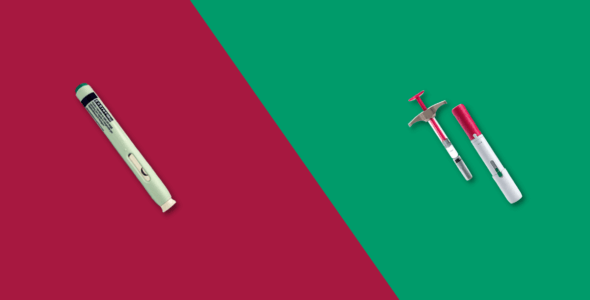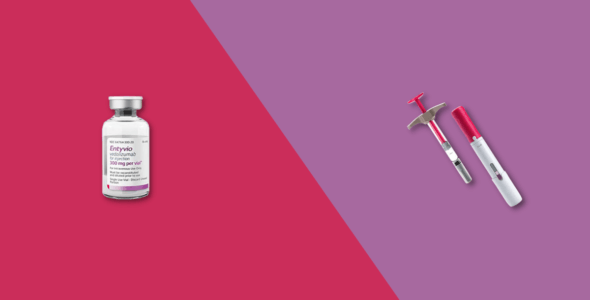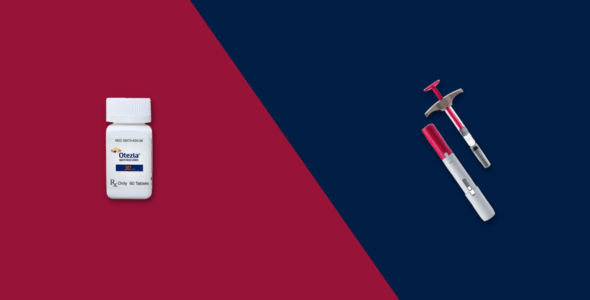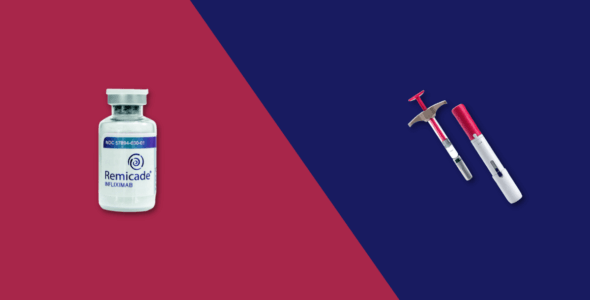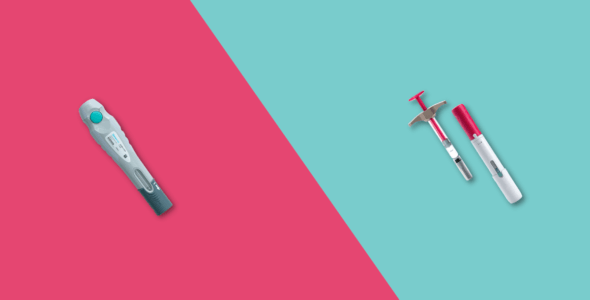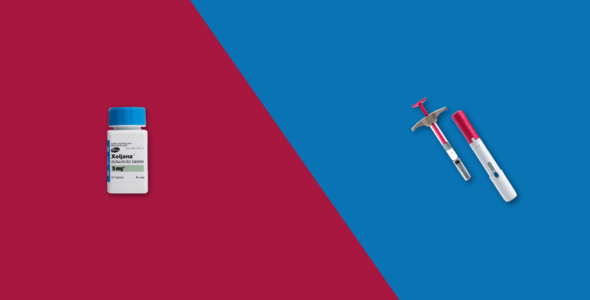Has your doctor spoken to you about Stelara or Humira? Do you want to find out more? Stelara and Humira are injectable prescription-only biologic therapies used to treat a range of inflammatory autoimmune diseases such as rheumatoid arthritis and non-autoimmune diseases such as Crohn’s Disease. There are many treatment options available for these conditions, the best treatment will be based on your condition, overall health, past or current treatments, and medical history. Stelara and Humira are similar drugs but aren’t in the same exact drug class. Read on to learn more about how these drugs compare.
What is Humira?
Humira is an immunosuppressant medication classed as a tumor necrosis factor (TNF) inhibitor or an anti-TNF, containing the active ingredient adalimumab.
Humira is approved by the FDA to treat the following inflammatory autoimmune diseases:
- Rheumatoid arthritis in adults
- Active psoriatic arthritis in adults
- Ankylosing spondylitis in adults
- Moderate to severe plaque psoriasis in patients who are candidates for systemic therapy or phototherapy in adults
- Juvenile idiopathic arthritis in children aged 2 years and older
Humira is also approved to treat similar non-autoimmune inflammatory diseases:
- Crohn’s Disease in adults and children aged 6 years and older
- Ulcerative colitis in adults in adults and children aged 2 years and older
- Hidradenitis suppurativa in adults and children aged 12 years and older
What is Stelara?
Stelara is classed as an immunosuppressant that’s used to weaken part of your immune system. It is specifically an interleukin-12 and interleukin-23 inhibitor drug containing the active ingredient ustekinumab. It is FDA approved to treat inflammatory diseases such as:
- Moderate to severely active Crohn’s disease in adults
- Moderate to severely active ulcerative colitis in adults
- Moderate to severe plaque psoriasis in adults and children 6 years of age and older
- Active psoriatic arthritis in adults
How does Humira work?
Both drugs work as monoclonal antibodies but in slightly different ways.
Humira works specifically as a TNF blocker, to treat inflammation. TNF alpha (tumor necrosis factor-alpha) is one of a number of different antibodies produced by white blood cells and other parts of the immune system.
Your immune system releases a protein called TNF-alpha in your body to trigger inflammation. Humira injected into your body helps reduce inflammation by attaching to TNF-alpha and stopping it from working and limiting the amount of inflammation your immune system can cause.
How does Stelara work?
Stelara works specifically by targeting two proteins in the body, interleukin-12 (IL-12) and interleukin-23 (IL-23). In people with psoriatic arthritis or Crohn’s disease, the body produces too much IL-12 and IL-23, causing excess inflammation when it is not needed. Stelara works by attaching to the proteins and blocking their activity. By reducing inflammation, Stelara can provide relief from the symptoms of inflammatory diseases. It can also limit the damage caused and stop flare-ups from happening.
How do you take Stelara and Humira?
You are given Stelara and Humira by subcutaneous injection (injecting it under your skin) using either a pre-filled syringe or an injectable pen. It is important to use a new needle each time to prevent the risk of infection. You may get injection site reactions such as redness, bruising, or irritation after administration, but this will settle down after a few hours. Your pharmacist or other healthcare providers can teach you how to give injections at home.
If you are prescribed Stelara to treat Crohn’s Disease, a type of inflammatory bowel disease (IBD), you will receive your first dose as an hour-long intravenous infusion in a medical setting by a healthcare professional. Your next doses will all be subcutaneous injections.
How effective are Stelara and Humira?
The first head-to-head clinical trial of biologics in patients with moderate-to-severe Crohn’s disease was carried out with Stelara and Humira by Janssen Pharmaceuticals, the manufacturers of Stelara. It was called the SEAVUE (Safety and Efficacy of Adalimumab Versus Ustekinumab for One Year) study, looking at patients who had never taken a biologic over the course of 52 weeks. The primary endpoint was clinical remission at 52 weeks, which 65% of patients treated with ustekinumab and 61% of patients treated with adalimumab achieved. One of the secondary endpoints was corticosteroid-free remission, which 61% of patients on Stelara achieved versus 57.4% of Humira patients.
Both medications work well for patients but the rates of clinical response after a year were not statistically significantly different between treatment groups. It is important to take your healthcare provider’s opinion in this regard. Your doctor knows what is best for you and will prescribe you one or the other based on your health condition.
What are the side effects of Stelara and Humira?
In clinical studies, the most common side effects of Stelara and Humira were
- Upper respiratory infections e.g sinus infection
- Headache
- Nausea
- Vomiting
- Joint pain
- Injection site reactions
Other common side effects mainly with Stelara
- Urinary tract infections
- Vaginal yeast infections
Other common side effects mainly with Humira
Serious side effects include:
- Suppression of the immune system
- Allergic reactions
- Serious infections
This is not a complete list and medical advice should be taken from your healthcare provider. Always inform your doctor of medicines you use, including over-the-counter drugs, herbal products, and supplements.
Can Stelara and Humira be used together?
No. Even though biologic drugs aren’t prescribed together, sometimes doctors prescribe biologic drugs with traditional biologic drugs such as methotrexate. Methotrexate is an older, less targeted drug that is used to reduce inflammation in your body.
What are the alternatives to Stelara and Humira?
Your healthcare provider has many biologic drugs available to prescribe such as Simponi (golimumab), Cimzia (certolizumab pegol), Enbrel (etanercept), Orencia (abatacept), Kineret (anakinra), Entyvio (vedolizumab), and Remicade (infliximab).
Can Stelara be used in children?
Stelara is used to treat moderate to severe plaque psoriasis in children aged 6 years and older. For this use, a child must be able to have phototherapy or systemic treatments to help their condition.
Can vaccines be taken when taking Stelara or Humira?
No. If you are taking Stelara or Humira you are advised to avoid live vaccines because they can make you more at risk of infection. Stelara and Humira dampen down your immune system, therefore, making you more prone to infection.

